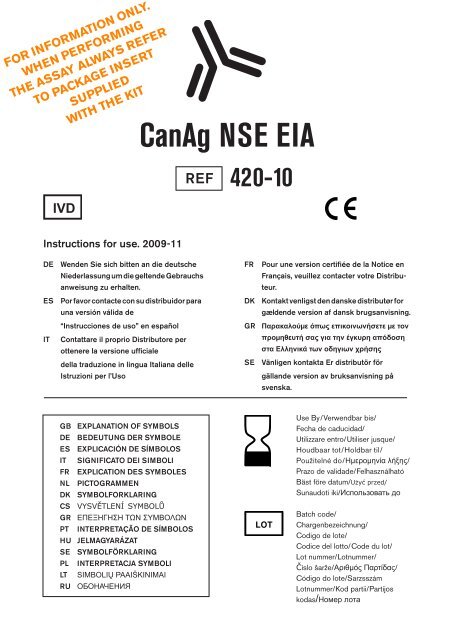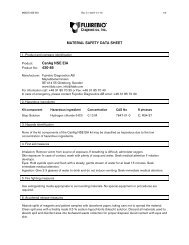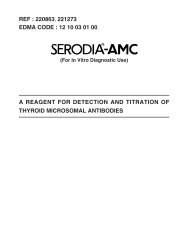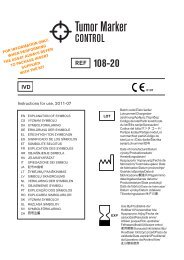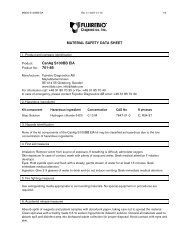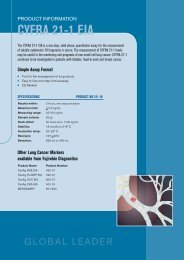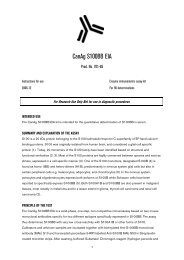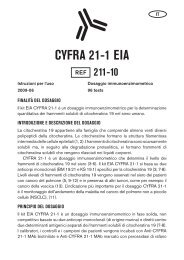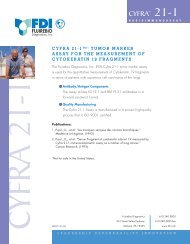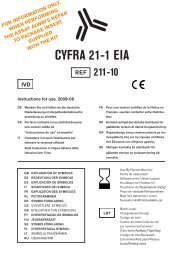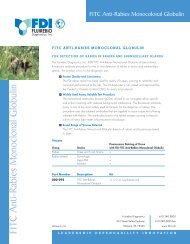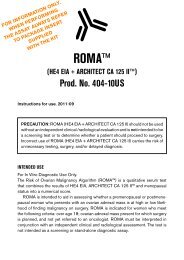canag nse eia - full package insert - Fujirebio Diagnostics, Inc.
canag nse eia - full package insert - Fujirebio Diagnostics, Inc.
canag nse eia - full package insert - Fujirebio Diagnostics, Inc.
- No tags were found...
You also want an ePaper? Increase the reach of your titles
YUMPU automatically turns print PDFs into web optimized ePapers that Google loves.
REFDate of manufacture/Herstellungsdatum/Fecha de fabricación/Data di fabbricazione/Date de fabrication/Produktie datum/Produktionsdato/Datum výroby/ΗμερομηνίαΠαραγωγής/Data de fabrico/Gyártás időpontja/Tillverkningsdatum/Data produkcji/Pagaminimo data/Дата производстваCatalogue number/Bestellnummer/Número de catálogo/Numero di catalogo/Référence ducatalogue/Catalogus nummer/Katalognummer/Katalogovéčíslo/Αριθμός καταλόγου/Referência de catálogo/Katalógusszám/Produktnummer/Numer katalogowy/Katalogo numeris/Номер по каталогуManufacturer/Hersteller/Fabricante/Fabbricante/Fabricant/Fabrikant/Producent/Výrobce/Kτασκευαστής/Fabricante/Gyártó/Tillverkare/Producent/Gamintojas/ПроизводительContains sufficient for tests/Inhalt ausreichend für Prüfungen/Contenido suficiente para ensayos/Contenuto sufficiente per“96” saggi/Contenu suffisant pour“96” tests/Inhoud voldoende voor “96”testen/Indeholder tilsttrækkeligttil ”96” test/Lze použit pro testů/Περιεχόμενο επαρκές για «96»εξετάσεις/Conteúdo suficiente para“96” ensaios/A doboz tartalma vizsgálat elvégzéséhez elegendő/Innehåller tillräckligt till “96” antal tester/Wystarczy na wykonanie testów/Turinys skirtas atlikti tyrimus/Содержит достаточные количествадля «96» определений2 o CIVD8 o CIn Vitro Diagnostic Medical Device/In Vitro Diagnostikum/Producto sanitariopara diagnóstico in vitro/Dispositivo medico-diagnostico in vitro/Dispositif médical de diagnostic in vitro/Medisch hulpmiddel voor in-vitrodiagnostiek/Medicinsk udstyr til invitro-diagnostik/In Vitro diagnostickýzdravotnický prostředek /In Vitro Διαγνωστικό Ιατροτεχνολογικόπροϊόν/Dispositivo médico paradiagnóstico in vitro/In vitrodiagnosztikum/Endast för in vitrodiagnostik/Wyróbdo diagnistyki InVitro/In Vitro Diagnostinė MedicinosPriemonė/Только для диагностикиIn VitroTemperature limitation/Temperaturbegrenzung/Límite de temperatura/Limiti di temperatura/Limites de température/Temperatuurlimiet/Temperaturbegrænsning/Teplotní rozmezí od do/Περιορισμοί θερμοκρασίας/Limites de temperatura/Hőmérséklettartomány/Temperaturbegränsning/Przestrzegać zakresu temperatury/Temperatūriniai apribojimai/Температурный режимConsult Instructions for Use/Gebrauchsanweisung beachten/Consulte las instrucciones de uso/Consultare le istruzioni per l‘uso/Consulter les instructions d‘utilisation/Raadpleeg de gebruiksaanwijzing/Se brugsanvisning/Viz návod kpoužití/Συμβουλευτείτε τις οδηγίεςχρήσης/Consulte as instruções deutilização/Nézze meg a Használatiutasítást/Se bruksanvisning/Sprawdźw instrukcji obsługi/Dėl naudojimožiūrėkite instrukcijas/Обратитесь к инструкции поприменению2
CONTBiological risks/Biogefährdung/Riesgo biológico/Rischio biologico/Risques biologiques/Biologischrisico/Biologisk fare/Biologicky nebezpečnéΒιολογικοί κίνδυνοι/Risco biológicoBiológiai kockázat/Biologisk risk/Ryzyko biologiczne/Biologinis pavojus/Биологическая опасностьContents of kit/Inhalt/Contenido/Contenudo/Contenu/Indhold/ανιδραστήρια/Kit innehåll/Rinkinio turinys/Компоненты набораORIG MOUORIG HUMFrom mouse/der Maus/de ratón/Murino/De souris/Mus/απο ποντίκι/Från mus/Pelės kilmės/Мышиного происхожденияHuman/Human/Humano/Origine Umana/Humaine/Humanδείγματα αναφοράς/Human/Žmogaus kilmės/Человеческого происхожденияWARNINGS AND PRECAUTIONSFor in vitro diagnostic use• For Professional Use Only• Please refer to the U.S. Department of Health and Human Services (Bethesda, Md., USA) publication No.(CDC) 88—8395 on laboratory safety procedures or any other local or national regulation.• Handle all patient specimens as potentially infectious.• Follow local guidelines for disposal of all waste material.CautionMaterial used in the preparation of human source reagent has been tested and found to be Non Reactive for HIV1 and 2 Antibody, HCV Antibody and Hepatitis B Surface Antigen (HBsAg). Since no method can completely ruleout the presence of blood borne diseases, the handling and disposal of human source reagents from this productshould be made as if they were potentially infectious.WARNHINWEISE UND VORSICHTSMASSNAHMENFür In-vitro-Diagnostik• Nur für geschultes Fachpersonal.• Bitte beachten Sie die Vorschriften zur Laborsicherheit in der Publikation Nr. (CDC) 88-8395 desUS Department of Health and Human Services (Bethesda, MD, USA) oder andere gleichwertige regionaleoder nationale Bestimmungen.• Alle Patientenproben gelten als potenziell infektiös und sind entsprechend zu handhaben.• Befolgen Sie die lokalen Richtlinien zur Entsorgung von anfallenden Abfallstoffen.AchtungDas zur Herstellung der Reagenzien aus humaner Quelle verwendete Material wurde auf HIV-1/2-Antikörper,HCV-Antikörper und Hepatitis-B-Oberflächenantigen (HBsAg) getestet und als nicht reaktiv befunden. Da es keineMethode gibt, mit der das Vorliegen von durch Blut übertragenen Krankheiten vollkommen ausgeschlossen werdenkann, sollten der Umgang mit Reagenzien aus humaner Quelle und deren Entsorgung so erfolgen, als handele essich um potenziell infektiöses Material.GBDE3
CUIDADOS Y PRECAUCIONESPara diagnóstico in vitro• Solo para uso profesional• Consultar la publicación del U.S. Department of Health and Human Services (Bethesda, Md., USA)publicationNo. (CDC) 88—8395 o las normas locales o nacionales.• Tratar todas las muestras de pacientes como potencialmente infecciosas.• Todos los residuos se deben tirar cumpliendo las normas en vigor.PrecauciónMaterial usado en la preparación de este reactivo se analizó la presencia de anticuerpos HIV 1 y 2, anticuerposHCV y antigenos de superficie de hepatitis B, siendo el resultado de dichos análisis negativo. Sin embargo, comoel test no puede excluir completamente los anticuerpos HIV 1 y 2, anticuerpos HCV y antigenos de superficie dehepatitis B, el manejo y disposición del reactivo debe ser como potencialmente infecciosas.AVVERTENZE E PRECAUZIONIPer uso diagnostico in vitro• Solamente per uso professionale• Come riferimento si consiglia la pubblicazione No. ( CDC ) 88-8395 del US Department of Health andHuman Service o qualsiasi altro regolamento locale o nazionale relativo alle Norme di Sicurezza da seguire neiLaboratori Diagnostici• Maneggiare I campioni dei pazienti come potenzialmente infetti• Seguire le normative vigenti relative all’eliminazione del materiale usatoPrecauzioniLe sostanze usate nella preparazione dei reagenti sono state testate e trovate Non Reattive per l’anticorpo anti-HIV1 e 2, per l’anticorpo anti-HCV e l’antigene di superficie dell’Epatite B (HbsAg). Tuttavia poichè nessun metododiagnostico è in grado di escludere completamente la possibilità di trasmissione di infezioni attraverso il sangue siconsiglia di maneggiare questi reattivi come potenzialmente infettivi.PRÉCAUTIONS D’EMPLOI ET MISE EN GARDEPour un usage diagnostic in Vitro• Pour usage professionnel seulement.• Prière de se référer à la Publication N° : (CDC) 88-8395 de l’U.S. Départment of Health and Human Services(Béthesda, Md., USA) sur les procédures de sécurité dans les laboratoires ou toutes autres réglementationslocales et nationales.• Manipuler les échantillons de patients comme potentiellement infectieux.• Suivre les réglementations locales pour l’élimination et le traitement de tous les déchets.AttentionLe matériel utilisé pour la préparation de réactifs d’origine humaine, a été testé et trouvé non réactif aux Anticorpsanti-virus de l’immunodéficience humaine (VIH-1/2), aux Anticorps de l’Hépatite C (VHC) et à l’Antigène de surfacede l’Hépatite B (AgHBs). Puisqu’il n’existe pas de méthode de test, rejetant complètement la présence de maladiesdans le sang, la manipulation et l’élimination de réactifs d’origine humaine doivent être effectuées comme s’ilsétaient potentiellement infectieux.ESITFR4
ADVARSLER OG FORHOLDSREGLERTil in vitro diagnostisk anvendelse• Kun til professionel brug• Der henvises til U.S. Department of Health and Human Services (de amerikanske sundhedsmyndigheder)(Bethesda, Md., USA) udgivelse nr. (CDC) 88-8395 vedrørende laboratoriesikkerhedsprocedurer eller andrelokale eller nationale forskrifter.• Alle patientprøver skal behandles som potentielt smittefarlige.• Følg lokale regler for afskaffelse af alt affald.AdvarselAlt materiale anvendt ved beredningen af reage<strong>nse</strong>r af human oprindelse er blevet testet og fundet negative for HIV1 og 2 antistoffer, HCV antistoffer og Hepatitis B overflade antigen (HbsAg). Da ingen analysemetoder fuldstændigkan udelukke tilstedeværelsen af blodbårne sygdomme, skal håndtering og bortskaffelse af reage<strong>nse</strong>r af humanoprindelse fra dette produkt behandles som potentielt smittefarligt.ΠΡΟΕΙΔΟΠΟΙΗΣΕΙΣ ΚΑΙ ΠΡΟΦΥΛΑΞΕΙΣΓια in vitro διαγνωσική χρήση• Για επαγγελµατική χρήση, µόνο.• Παρακαλούμαι όπως επικαλεστείτε τις οδηγίες ασφαλούς λειτουγίας των εργαστηρίων του ΤμήματοςΥγείας και Ανθρωπινων Υπηρεσιών των Η.Π.Α.(U.S. Department of Health and Human Services)(Bethesda, Md., USA) αριθμός έκδοσης (CDC) 88—8395, ή οποιοδήποτε άλλο κατά τόπους σχετικόΕθνικό κανονισμό.• Μεταχειριστήτε όλα τα δείγματα ως μολυσμένα.• Ακολουθείστε τις κατά τόπου οδηγίες για απομάκρυνση άχρηστου υλικού.ΠροσοχήΟλα τα υλικά που χρησιµοποιούται για την παρασκευή αντιδραστηρίων ανθρώπινης προέλευσης έχουνεξετασθεί και έχουν ßρεθεί αρνητικά για HIV/ HIV/ -1/2 Αντίσωµα (Ab), HCV Αντίσωµα (Ab) και Ηπατίτιδας B Αντι Αντι Αντι Αντι Αντι Αντι Αντι Αντι Αντι Αντι Αντιγόνο Επιφανειας (Hepatitis B Surface Antigen) (HBsAg). Εφ΄όσον δεν υπάρχει µέθοδος ικανή να αποκλείσειαπόλυτα την παρουσία αιµατολογικών / µολυσµατικών ασθενειών, ο τρόπος µεταχείρισης και η αποµάκρυνσηαντιδραστηρίων ανθρώπινης προέλευσης αυτού του συγκεκριµένου προίοντος, πρέπει να είναι ίδιος µε αυτόνπου ακολουθείται για µολυσµένα δείγµατα.DKGRVARNINGAR OCH SÄKERHETSÅTGÄRDEREndast för in vitro diagnostik• Endast för professionellt bruk• Följ “U.S. Department of Health and Human Services (Bethesda, Md., USA) publikation (CDC) 88—8395”eller annan lokal eller nationell bestämmelse beträffande laboratoriesäkerhet.• Hantera alla patientprover som potentiellt smittsamma.• Följ lokala bestämmelser för bortskaffande av avfall.VarningMaterial som använts för tillverkning av reagens med humant ursprung har testats och befunnits negativt för HIV 1och 2 antikroppar, HCV antikroppar samt hepatit B ytantigen (HBsAg). Eftersom inget test <strong>full</strong>ständigt kan uteslutaev. närvaro av blodsmitta skall hantering och bortskaffande av humant material från denna produkt ske som om denvore potentiellt infektiös.SE5
CanAg NSE EIAGBInstructions for useEnzyme immunometric assay kitFor 96 determinationsINTENDED USEThe CanAg NSE EIA kit is intended for the quantitative determination of NSE inhuman serum.SUMMARY AND EXPLANATION OF THE ASSAYThe glycolytic enzyme enolase (2-phospho-D-glycerate hydrolase, EC 4.2.1.11)exists as several dimeric isoenzymes (αα, αβ, αγ, ββ and γγ) composed of threedistinct subunits α, β and γ. The γ unit is found either in a homologous γγ- or in aheterologous αγ-isoenzyme and is known as neuron-specific enolase (NSE). Themonoclonal antibodies used in the CanAg NSE EIA bind to the γ-subunit of theenzyme and thereby detects both the γγ and the αγ forms (1, 2). The NSE levelsare low in healthy subjects and subjects with benign diseases. Elevated levelsare commonly found in patients with malignant tumours with neuroendocrine differentiation,especially small cell lung cancer (SCLC) (3) and neuroblastoma (4).Quantitative determination of NSE in serum may be valuable in the managementof patients with suspected or diagnosed SCLC or neuroblastoma, to aid in thedifferential diagnosis and to monitor the effect of treatment (5, 6).PRINCIPLE OF THE TESTThe CanAg NSE EIA is a solid phase, non-competitive immunoassay based ontwo monoclonal antibodies (derived from mice) directed against two separateantigenic determinants of the NSE molecule. The monoclonal antibodies (MAb)used bind to the γ-subunit of the enzyme and thereby detects both the γγ and theαγ form. Calibrators and patient samples are incubated together with biotinylatedAnti-NSE MAb E21 and horseradish peroxidase (HRP) labelled Anti-NSE MAbE17 in streptavidin coated micro strips. After washing, buffered Substrate/Chromogen reagent (hydrogen peroxide and 3, 3’, 5, 5’ tetramethylbenzidine) isadded to each well and the enzyme reaction is allowed to proceed. During theenzyme reaction a blue colour will develop if antigen is present. The intensityof the colour development is proportional to the amount of NSE present in thesamples.6
The colour intensity is determined in a microplate spectrophotometer at 620 nm(or optionally at 405 nm after addition of Stop Solution).Calibration curves are constructed for each assay by plotting absorbancevalue versus the concentration for each calibrator. The NSE concentrations ofpatient samples are then read from the calibration curve.REAGENTS• Each CanAg NSE EIA kit contains reagents for 96 tests.• The expiry date of the kit is stated on the label on the outside of the kit box.• Do not use the kit beyond the expiry date.• Do not mix reagents from different kit lots.• Store the kit at 2–8°C. Do not freeze.• Opened reagents are stable according to the table below provided they arenot contaminated, stored in resealed original containers and handled asprescribed. Return to 2–8°C immediately after use.Component Quantity Storage and stabilityafter first openingMICROPLAMicroplate 1 Plate 2—8°C until expirydate stated on the plate12 x 8 breakable wells coated with streptavidin. After opening, immediatelyreturn unused strips to the aluminium pouch containing desiccant and resealcare<strong>full</strong>y to keep dry.NSE Calibrators 5 vials, lyophilised 4 weeks at 2–8°C3 months at –20°CCAL NSE ACAL NSE BCAL NSE CCAL NSE DCAL NSE E1 x 0.75 mL1 x 0.75 mL1 x 0.75 mL1 x 0.75 mL1 x 0.75 mL7
The lyophilised calibrators contain human NSE in a protein matrix with 0.01 %of a non-azide preservative. To be reconstituted with 0.75 mL distilled waterbefore use.NOTE: The exact NSE concentration is lot specific and is indicated on the labelof each vial.Component Quantity Storage and stabilityafter first openingBIOTINAnti-NSEBiotin Anti-NSE 1 x 15 mL 2—8°C until expirydate stated on the vialBiotin Anti-NSE monoclonal antibody from mouse, approximately 2 µg/mL. Containsphosphate buffer (pH 7.1), bovine serum albumin, blocking agents, an inertblue dye and 0.01 % methyl-isothiazolone (MIT) as preservative. To be mixed withTracer, HRP Anti-NSE before use.CONJAnti-NSETracer, HRP Anti-NSE 1 x 0.75 mL 2—8°C until expirydate stated on the vialStock solution of HRP Anti-NSE monoclonal antibody from mouse, approximately40 µg/mL. To be mixed with Biotin Anti-NSE prior to use. Contains 0.02 %methyl-isothiazolone (MIT), 0.02 % bromonitrodioxane and 20 ppm Proclin 300as preservatives.SUBSTMBTMB HRP-Substrate 1 x 12 mL 2—8°C until expirydate stated on the vialReady for use. Contains buffered hydrogen peroxide and 3, 3’, 5, 5’ tetramethylbenzidine(TMB).8
Component Quantity Storage and stabilityafter first openingSTOPStop Solution 1 x 15 mL 2—8°C until expirydate stated on the vialReady for use. Contains 0.12 M hydrochloric acid.WASHBUF25XWash Concentrate 1 x 50 mL 2—8°C until expirydate stated on the bottleTo be diluted with water 25 times before use. A Tris-HCl buffered salt solutionwith Tween 20. Contains Germall II as preservative.Indications of instabilityThe TMB HRP-Substrate should be colourless or slightly bluish. A blue colourindicates that the reagent has been contaminated and should be discarded.WARNINGS AND PRECAUTIONSFor in vitro diagnostic use• For Professional Use Only• Please refer to the U.S. Department of Health and Human Services(Bethesda, Md., US) publication No. (CDC) 88-8395 on laboratory safetyor any other local or national regulation.• Handle all patient specimens as potentially infectious.• Follow local guidelines for disposal of all waste material.CautionEach donor unit used in the preparation of human source reagent has beentested and found to be Non Reactive for HIV-1/2 Antibody, HCV Antibody andHepatitis B Surface Antigen (HBsAg). Since no method can completely ruleout the presence of blood borne diseases, the handling and disposal of humansource reagents from this product should be made as if they were potentiallyinfectious.9
SPECIMEN COLLECTION AND HANDLINGThe CanAg NSE EIA is intended for use with serum. Collect blood by venipunctureand separate the serum according to common procedures. Serum should beseparated from the clot within 60 minutes of collection to avoid leaking of NSEfrom blood cells. Do not use haemolysed samples. Plasma is not recommendedsince significant amounts of NSE can be released from platelets. Samples canbe stored at 2—8°C for 24 hours. For longer periods store samples at -70°Cor below. Samples should not be stored in a self-defrosting freezer and not bethawed and refrozen before analysis. Bring frozen samples to room temperatureand mix THOROUGHLY by gently inverting multiple times before analysis. Samplesthat contain gross particulates should be centrifuged at 10.000 x g for 10minutes, prior to use to eliminate any particulate matter that may have developedfrom the thawing process. Analyze thawed samples within one hour.PROCEDUREMaterials required but not supplied with the kit1. Microplate shakerShaking should be medium to vigorous. Longitudinal shaking approximately200 strokes/min, oscillations 700—900/min.2. Microplate wash deviceAutomatic platewash capable of performing 1 and 6 washing cycles, or semimanual microplate washing device connected to vacuum pump orwater-jet vacuum and a liquid trap for retaining aspirated liquid.The Nunc Immuno-8 manual strip washer is recommended if an automaticmicroplate wash is not used.3. Microplate spectrophotometerWith a wavelength of 620 nm and/or 405 nm, and an absorbance range of0 to 3.0.4. Precision pipettesWith disposable plastic tips for dispensing microlitre volumes. An 8-channelpipette or respe<strong>nse</strong>r pipette with disposable plastic tips for delivery of 100µL is useful but not essential. Pipettes for dispensing millilitre volumes.5. Distilled or deionized waterFor reconstitution of NSE Calibrators and for preparation of diluted washsolution.10
Procedural notes1. A thorough understanding of this <strong>package</strong> i<strong>nse</strong>rt is necessary to ensure properuse of the CanAg NSE EIA kit. The reagents supplied with the kit are intendedfor use as an integral unit. Do not mix identical reagents from kits havingdifferent lot numbers. Do not use the kit reagents after the expiry date printedon the outside of the kit box.2. Reagents should be allowed to reach room temperature (20–25°C) prior to use.The assay should only be performed at temperatures between 20—25°C toobtain accurate results. Frozen sera must be gently but thoroughly mixed afterthawing.3. Before starting to pipette calibrators and patient specimens it is advisableto mark the strips to be able to clearly identify the samples during and afterthe assay.4. The requirement for efficient and thorough washing for separation of bound andunbound antigen and reagents from the solid-phase bound antibody-antigencomplexes is one of the most important steps in an EIA. In order to ensureefficient washing make sure that all wells are completely filled to the top edgewith wash solution during each wash cycle, that wash solution is dispe<strong>nse</strong>dat a good flow rate, that the aspiration of the wells between and after the washcycles is complete and that the wells are empty. If there is liquid left, invert theplate and tap it care<strong>full</strong>y against absorbent paper.- Automatic strip washer: Follow the manufacturer’s instructions for cleaningand maintenance diligently and wash the required number of wash cyclesprior to and after each incubation step. It’s highly recommended touse strip process mode and overflow wash mode with a dispensingvolume of 800 µL. The aspiration/wash device should not be left standingwith the Wash Solution for long periods, as the needles may getclogged resulting in poor liquid delivery and aspiration.5. The TMB HRP-Substrate is very sensitive for contamination. For optimal stabilityof the TMB HRP-Substrate, pour the required amount from the vial to a care<strong>full</strong>ycleaned reservoir or preferably a disposable plastic tray to avoid contaminationof the reagent. Be sure to use clean disposable plastic pipettetips (or respe<strong>nse</strong>r pipette tip).6. Be sure to use clean disposable plastic pipette tips and a proper pipettingtechnique when handling samples and reagents. Avoid carry-over by holdingthe pipette tip slightly above the top of the well and avoid touching the plasticstrip or surface of the liquid. A proper pipetting technique is of particularimportance when handling the TMB HRP-Substrate solution.11
Protocol SheetCanAg NSE EIA REF 420-10Mix the components directly before use. Use shaking conditions according to the Instructions.Step Bottle/Plate Procedure1. Prepare NSE CalibratorsCAL NSEA, B, C, D, EAdd 0.75 mL of distilled water to each vial andmix gently. Allow to stand for at least 15 minutes.NOTE: The exact concentration of each calibratoris stated on the label. This value of the calibratorsshould be used for calculations.2. Prepare Wash SolutionWASHBUF 25XDilute 50 mL of Wash Concentrate with 1200 mLof distilled water or deionized water.3. Prepare Antibody SolutionCONJBIOTINAnti-NSEAnti-NSEMix 50 µL of Tracer, HRP Anti-NSE with 1 mL ofBiotin Anti-NSE per strip:No. of HRP Anti-NSE Biotin Anti-NSEStrips (µL) (mL)1 50 12 100 23 150 34 200 412
4. Wash5. Add calibrators and samples6. Add Antibody Solution7. <strong>Inc</strong>ubate8. Wash9. Add TMB HRP-Substrate10. <strong>Inc</strong>ubate11. Read absorbanceAlt.11 Add Stop SolutionAlt.12 <strong>Inc</strong>ubateAlt.13 Read absorbanceMICROPLACAL NSEA, B, C, D, EANTIBODY SOLUTIONMICROPLAMICROPLASUBSTMBMICROPLAMICROPLASTOPMICROPLAMICROPLA5 250 56 300 67 350 78 400 89 450 910 500 1011 550 1112 600 12Wash each well once with Wash Solution25 µL in each well100 µL in each well1 hour shaking at room temperatureWash each well six times with Wash Solution100 µL in each well30 min shaking at room temperature620 nm100 µL in each well1 min shaking at room temperatureRead at 405 nm within 15 min13
Preparation of reagentsStability of prepared reagentNSE Calibrators4 weeks at 2—8°C3 months at -20°CAdd exactly 0.75 mL of distilled water to each vial and mix gently. Allow standingfor at least 15 minutes to reconstitute. NOTE: The concentration of the calibratorsis stated on the labels and should be used for calculation of the results.Wash Solution2 weeks at 2—25°Cin a sealed containerPour the 50 mL Wash Concentrate into a clean container and dilute 25-fold byadding 1200 mL of distilled or deionised water to give a buffered Wash Solution.Antibody Solution3 weeks at 2—8°CPrepare the required quantity of Antibody Solution by mixing 50 µL of Tracer,HRP Anti-NSE with 1 mL of Biotin Anti-NSE per strip (see table below):No. of Tracer, HRP Anti-NSE Biotin Anti-NSEStrips (µL) (mL)1 50 12 100 23 150 34 200 45 250 56 300 67 350 78 400 89 450 910 500 1011 550 1112 600 12Be sure to use a clean plastic or glass bottle for preparation of Antibody Solution.Alternative: Pour the content of the Tracer, HRP Anti-NSE into the vial of BiotinAnti-NSE and mix gently. Be sure that all content of the Tracer is transferred tothe vial of Biotin Anti-NSE.NOTE: The Antibody Solution is stable for 3 weeks at 2–8°C. Do not preparemore Antibody Solution than will be used within this period and make sure that itis stored properly.14
Assay procedurePerform each determination in duplicate for both calibrators and patient samples.A calibration curve should be run with each assay. All reagents and samplesmust be brought to room temperature (20—25 °C) before use.1. Start to prepare NSE Calibrators, Wash Solution and Antibody Solution.It is important to use clean containers. Follow the instructions care<strong>full</strong>y.2. Transfer the required number of microplate strips to a strip frame.(Immediately return the remaining strips to the aluminium pouch containing adesiccant and reseal care<strong>full</strong>y). Wash each strip once with the Wash Solution.Do not wash more strips than can be handled within 30 min.3. Pipette 25 µL of the NSE Calibrators (CAL A, B, C, D, E) and patientspecimens (unknowns-Unk) into the strip wells according to the followingscheme:1 2 3 4 5 6 7 etcA Cal Cal 4thA E UnkB Cal Cal etcA EC Cal 1stB UnkD Cal 1stB UnkE Cal 2ndC UnkF Cal 2ndC UnkG Cal 3rdD UnkH Cal 3rdD Unk4. Add 100 µL of Antibody Solution to each well using a 100 µL precisionpipette (or an 8-channel 100 µL precision pipette). Avoid carry-over by holdingthe pipette tip slightly above the top of the well and avoid touching theplastic strip or surface of the liquid.5. <strong>Inc</strong>ubate the plate for 1 hour (± 10 min) at room temperature (20-25°C)with constant shaking of the plate using a microplate shaker.6. After the incubation aspirate and wash each strip 6 times.15
7. Add 100 µL of TMB HRP-Substrate to each well using the same procedureas in item 4. The TMB HRP-Substrate should be added to the wells asquickly as possible and the time between addition to the first andlast well should not exceed 5 min.8. <strong>Inc</strong>ubate for 30 min (± 5 min) at room temperature with constant shaking.Avoid exposure to direct sunlight.9. Immediately read the absorbance at 620 nm in a microplate spectrophotometer.OptionIf the laboratory does not have access to a microplate spectrophotometer capableof reading at 620 nm the absorbance can be determined as in item 10.10. Add 100 µL of Stop Solution, mix and read the absorbance at 405 nm in amicroplate spectrophotometer within 15 min after addition of StopSolution.Measurement rangeThe CanAg NSE EIA measures concentrations between 1 and approximately150 µg/L. If NSE concentrations above the measuring range are to be expected,it is recommended to dilute samples with normal human serum prior to analysis.NOTE: The serum used for dilution should also be measured in order to determinethe endogenous NSE concentration (see “Calculation of results”).Quality controlCanChek Tumor Marker Control Sera Levels 1 and 2 (available separately,REF 107-20) are recommended for validation of the assay series. If valuesoutside of the specified range are obtained, a complete check of reagents andreader performance should be made and the analysis repeated.Reference materialsSince no common reference material is available for NSE antigen, CanAg NSEEIA Calibrator values are assigned against a set of in-house reference standards.CALCULATION OF RESULTSIf a microplate spectrophotometer with built-in data calculation program is usedrefer to the manual for the spectrophotometer and create a program using theconcentration stated on the label of each of the NSE calibrators.For automatic calculation of NSE results it is recommended to use either of thefollowing methods:16
• Cubic spline curve fit method. Calibrator A should be included in the curvewith the value 0 µg/L.• Spline smoothed curve fit method. Calibrator A should be used as plateblank.• Interpolation with point-to-point evaluation. Calibrator A should be includedin the curve with the value 0 µg/L.• Quadratic curve fit method. Calibrator A should be included in the curvewith the value 0 µg/L.NOTE: 4-Parametric or Linear regression evaluation methods should not be used.For manual evaluation, a calibration curve is constructed by plotting the absorbance(A) values obtained for each NSE Calibrator against the correspondingNSE concentration (in µg/L), see figure. The unknown NSE concentrations canthen be read from the calibration curve using the mean absorbance value ofeach patient specimen. If samples in an initial analysis give NSE levels abovethe concentration of calibrator E, it is necessary to dilute the sample 1/10 withnormal human serum in order to obtain accurate results. The result should thenbe calculated according to the following procedure:Dilution 1/10: 10 x ([NSE] Diluted sample- (0.9 x [NSE] Normal human serum))Example of resultsSpecimen Calibrator Mean abs NSEvalues value (A) µg/LCAL NSE ACAL NSE BCAL NSE CCAL NSE DCAL NSE E0 µg/L 0.0377.5 µg/L 0.23822.9 µg/L 0.66368.4 µg/L 1.688138.0 µg/L 2.720Specimen 1 0.518 17.5Specimen 2 1.474 57.817
2.82.42.0A 620 nm1.61.20.80.400 20 40 60 80 100 120 140NSE µg/LExample, do not use this curve to determine assay results.The exact NSE concentration is indicated on the label of each calibrator vial.LIMITATIONS OF THE PROCEDUREThe level of NSE cannot be used as absolute evidence for the presence orabsence of malignant disease and the NSE test should not be used in cancerscreening. The results of the test should be interpreted only in conjunction withother investigations and procedures in the diagnosis of disease and the NSE testshould not replace any established clinical examination.Elevated NSE values not due to tumours may occur in dialysis patients andpatients with leukaemic diseases.Serum should not contain visible haemolysis (the absorbance at 500 nm fornon-turbid sample should not exceed 0.3) since erythrocytes contain significantamounts of NSE (7). Prolonged storage of whole blood can cause release ofNSE from the blood cells.Anti-reagent antibodies (human anti-mouse antibody (HAMA) or heterophilicantibodies) in the patient sample may occasionally interfere with the assay, eventhough specific blocking agents are included in the buffer.EXPECTED VALUESHealthy individuals are expected to have NSE values below 13 μg/L. It is recommendedthat each laboratory establish its own normal range to account for suchlocal environmental factors as diet, climate, living conditions, patient selection,etc.18
PERFORMANCE CHARACTERISTICSPrecisionTotal precision was determined according to NCCLS guideline EP5-A (8) usingfour levels of frozen pooled human serum containing added NSE. Each samplewas randomly pipetted in duplicates and analysed twice each day over 20 days.The analyses were undertaken during a period of 40 months, by > three differenttechnicians and using 20 different CanAg NSE EIA kit batches.SampleReplicates Mean Within-run Within-run Between-day Between-dayµg/L SD (µg/L) CV % SD (µg/L) CV %NSE 1 80 10.3 0.24 2.3 0.57 5.5NSE 2 80 23.7 0.82 3.5 0.97 4.1NSE 3 80 48.2 1.02 2.1 1.93 4.0NSE 4 80 92.7 1.60 1.7 3.44 3.7Detection limitThe detection limit of the CanAg NSE EIA assay is < 1 µg/L defined as theconcentration corresponding to the mean of the absorbance values for the NSECalibrator A plus 2 standard deviations according to the formula:Hook effectNo hook effect has been noticed for NSE concentrations up to 200 000 µg/L.Linearity2 x SD CAL AOD CAL B–OD CAL Ax [CAL B] µg/LPatient samples were diluted with normal serum and analysed. The obtainedvalues were in the range 93—101 % of the expected values.19
SpecificityThe monoclonal antibodies used are specific for the γ-subunit of enolase. Nomeasurable cross-reactions with other enolase have been observed.The NCCLS guideline EP7-P (9) was followed to determine possible sourcesof interference. The following substances and concentrations were tested andfound not to interfere with the test.Concentration with nosignificant (± 10%) interferenceLipemia (Intralipid ® )Bilirubin, unconjugated10 mg/mL0.6 mg/mL20
WARRANTYThe performance data presented here were obtained using the assay procedureindicated. Any change or modification of the procedure not recommended by<strong>Fujirebio</strong> <strong>Diagnostics</strong> may affect the results, in which event <strong>Fujirebio</strong> <strong>Diagnostics</strong>disclaims all warranties expressed, implied or statutory including the implied warrantyof merchantability and fitness for use.21
LITERATURE REFERENCES1. Paus E. and Nustad K., (1989) Immunoradiometric Assay for αγ- andγγ-Enolase (Neuron-Specific Enolase), with Use of Monoclonal Antibodiesand Magnetizable Polymer Particles. Clin. Chem. 35: 2034-2038.2. Dahlén U., Karlsson B., Nilsson O. and Uhl W., (1995) Development of anEnzyme Immunoassay, NSE-Enzymun Test For Determination of Neuron-Specific Enolase. XXIII International Society for Oncodevelopmental Biologyand Medicine, Montréal, Ouébec .3. Cooper E.H., (1994) Neuron-specific enolase. The International Journal ofBiological Markers 9(4):205-10.4. Cooper E.H., Pritchard J., Bailey C.C. and Ninane J., (1987) Serum neuronspecificenolase in children’s cancer. Br. J. Cancer 56: 65—67.5. Schneider, P. M. et al., (2002) Lung Cancer. In "Tumor markers, Physiology,Pathobiology, Technology and Clinical Applications” Eds. Diamandis E. P. etal., AACC Press, Washington pp 287-303.6. Bonner J. A., Sloan JA., Rowland KM., Klee GG., Kugler JW., Mailliard JA.,Wiesenfeld M., Krook JE.,Maksymiuk AW., Shaw EG., Marks RS and PerezEA., (2000) Significance of Neuron-specific Enolase Levels before andduring Therapy for Small Cell Lung Cancer. Clinical Cancer Research 6:597-601.7. Påhlman S., Esscher T., Bergvall P. and Odelstad L., (1984) Purificationand characterization of human neuron-specific enolase: Radioimmunoassaydevelopment. Tumor Biol. 5: 127—139.8. National Committee for Clinical Laboratory Standards, Evaluation of PrecisionPerformance of Clinical Chemistry Devices. Approved Guideline EP5-A(1999).9. National Committee for Clinical Laboratory Standards, National EvaluationProtocols for Interference Testing, Evaluation protocol Number 7, Vol. 6, No13, August (1986).22
CanAg ® is a registered trademark of <strong>Fujirebio</strong> <strong>Diagnostics</strong> AB<strong>Fujirebio</strong> <strong>Diagnostics</strong> ABElof Lindälvs gata 13SE-414 55 GöteborgSwedenPhone + 46 31 85 70 30Fax + 46 31 85 70 40info@fdab.comwww.fdab.com24CanAg NSE EIA Prod. No. 420-10, 2009-11. F5172, r6


